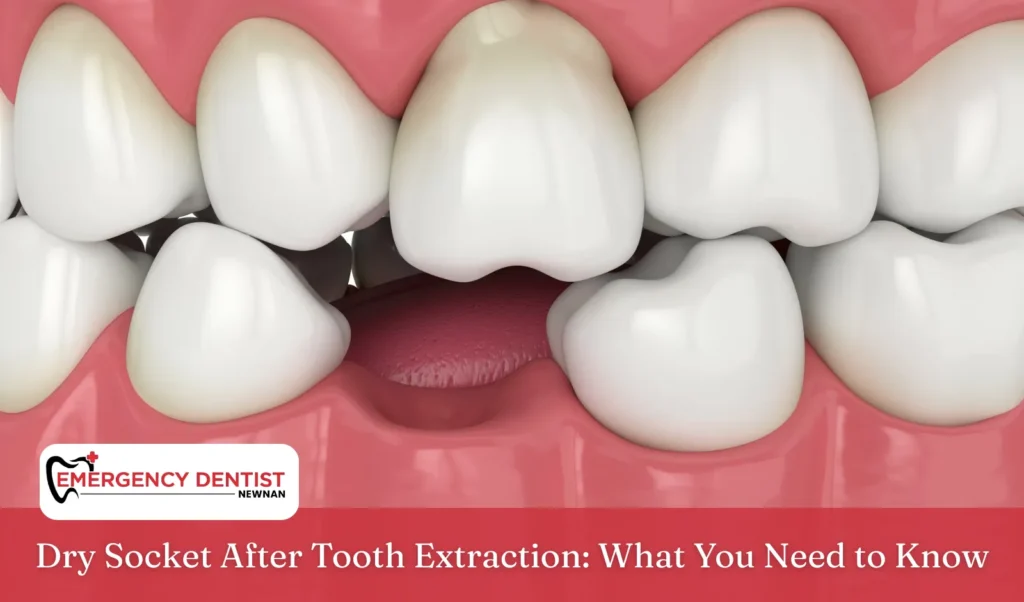Dry Socket After Tooth Extraction: What You Need to Know

Having a tooth pulled is a routine dental procedure, but sometimes recovery doesn’t go as smoothly as expected. One painful complication that may occur after tooth extraction is a dry socket. Many patients ask, what is a dry socket after tooth extraction or what is a dry socket in tooth extraction? This article explains the condition clearly, what it is, why it happens, the symptoms of dry socket, how to prevent dry socket, and when to see an Emergency Dentist in Newnan to ensure your socket heals safely.
What Is a Dry Socket in Tooth Extraction?
A dry socket, also called alveolar osteitis, is a painful issue that may appear after removing a tooth. Normally, after extraction, a blood clot forms in the socket. This clot is vital because it protects the bone and nerve and supports the healing process.
If the clot dissolves too soon, is disturbed, or doesn’t form properly, the socket is left with exposed bone and sensitive tissue. Instead of progressing smoothly, the area becomes inflamed and very painful. Though not everyone will experience this condition, it is one of the most common complications following wisdom teeth removal.
What Causes a Dry Socket?

A number of factors can interfere with healing and lead to developing dry socket:
- Rinsing or trying to rinse your mouth forcefully before the clot stabilizes.
- Smoking or using straws, which create suction and may remove the clot that forms in the socket.
- Taking birth control pills, since hormonal changes may raise the risk.
- Poor oral hygiene or a pre-existing infection.
- Trauma during surgery or difficulty when a tooth is pulled.
These problems can prevent a stable clot from staying in place, leaving the area open to bacteria and irritation.
Symptoms of Dry Socket
Recognizing the signs early makes treatment easier. Common symptoms of dry socket include:
- Severe pain that starts or worsens a few days after tooth extraction.
- A visible opening with exposed bone inside the socket.
- Persistent bad taste or noticeable bad breath.
- Pain that spreads to the ear, temple, or eye.
- Slower than expected socket heals compared to normal recovery.
If these symptoms appear, see an Emergency Dentist in Newnan for prompt care.
How to Prevent Dry Socket

The best way to handle dry socket is to avoid it in the first place. After removing a tooth, follow your dentist’s directions carefully:
- Do not smoke, spit, or use straws for at least 48 hours.
- Eat soft foods like yogurt, mashed potatoes, and smoothies.
- Allow the blood clot to form naturally and don’t disturb it.
- After 24 hours, use a gentle salt water rinse to keep the site clean.
- Brush and floss carefully near the area without touching the socket.
Protecting the clot lowers the risk of developing dry socket and helps your mouth heal more comfortably.
How an Emergency Dentist in Newnan Can Treat Dry Socket
If prevention isn’t enough, an Emergency Dentist in Newnan can treat dry sockets with professional care. Treatment may involve:
- Cleaning the socket to remove debris or bacteria.
- Placing medicated dressings to relieve pain and protect the tissue.
- Prescribing antibiotics or pain relievers when needed.
These steps not only reduce discomfort but also help the socket heal properly.
Wisdom Teeth Removal and Dry Socket Risks
Dry socket occurs more often after wisdom teeth removal. These teeth are located in the back of the mouth, which is harder to keep clean, and the sockets are larger, which makes them more likely to have problems if the blood clot forms incorrectly.
Because of this, patients who undergo removing a tooth in this area should take extra care. Eating soft foods, using gentle cleaning methods, and attending follow-up appointments with their dentist are all important steps to prevent developing dry socket.
Conclusion
A dry socket after tooth extraction can cause significant pain, but understanding the condition makes recovery easier. When a blood clot forms in the socket, it shields the site and protects the bone and nerve, allowing the socket heal naturally. If the clot is disturbed, though, issues like exposed bone, swelling, and severe discomfort can develop.
The good news is that you can prevent dry socket by avoiding straws, smoking, or forceful rinsing, and by eating soft foods with gentle salt water rinses. If the symptoms of dry socket include lasting pain or bad breath, an Emergency Dentist in Newnan can quickly treat dry socket and restore your comfort.



